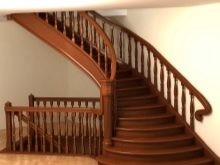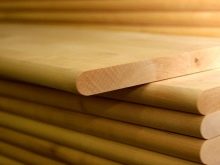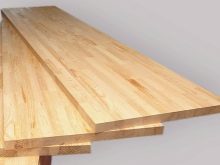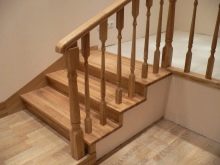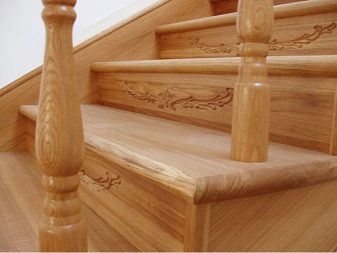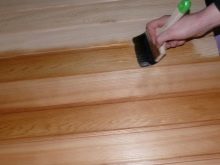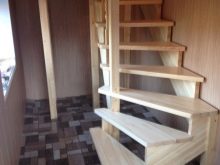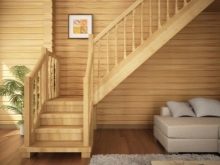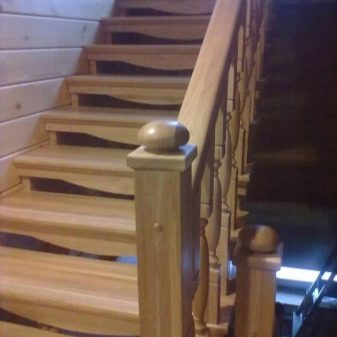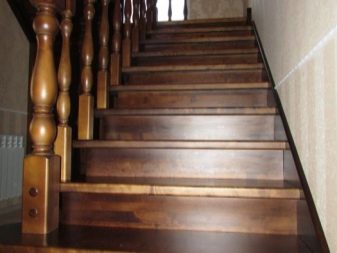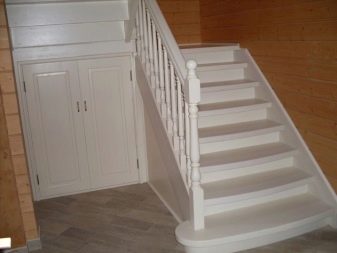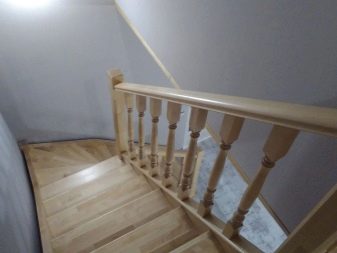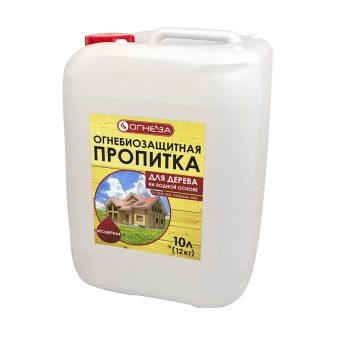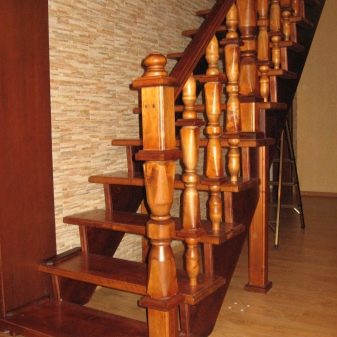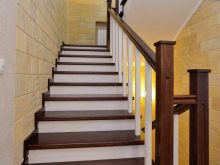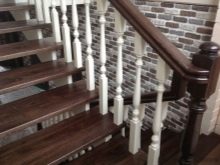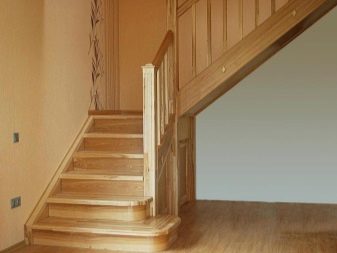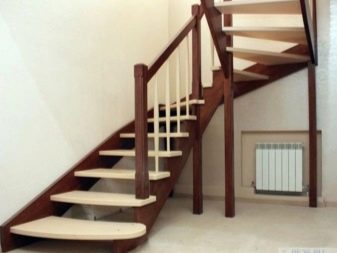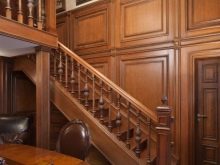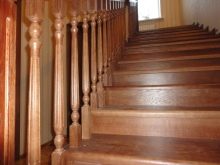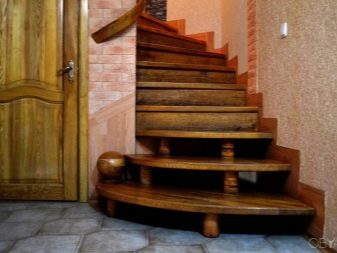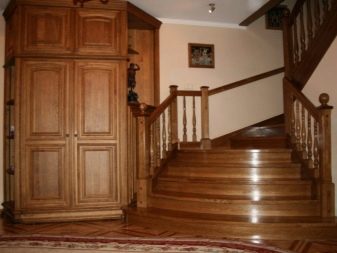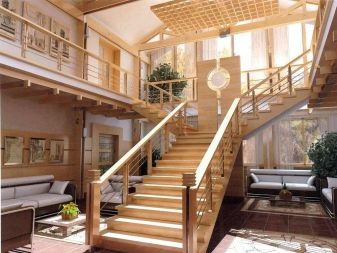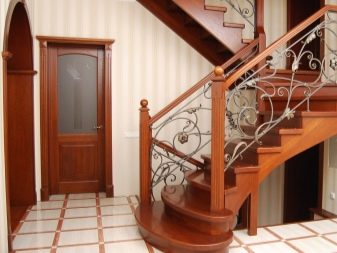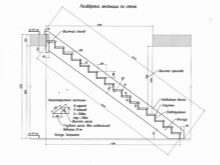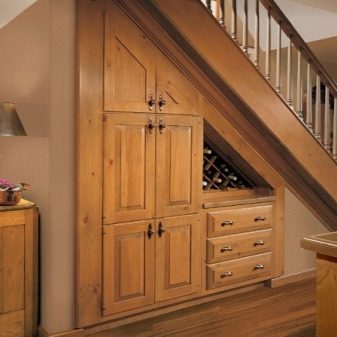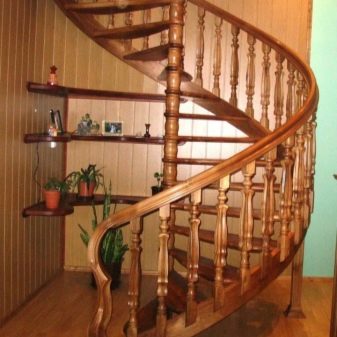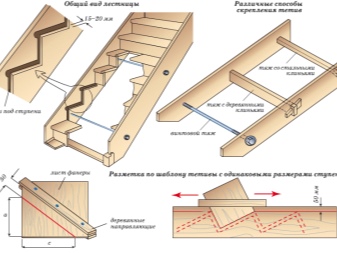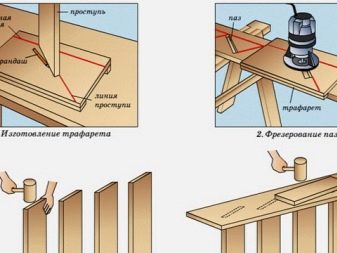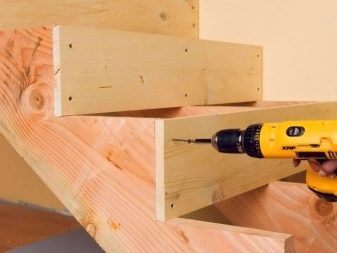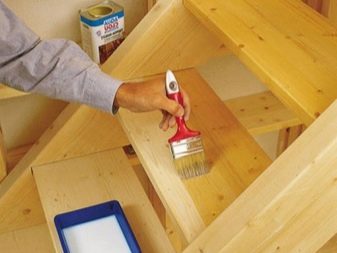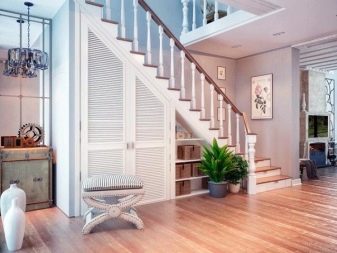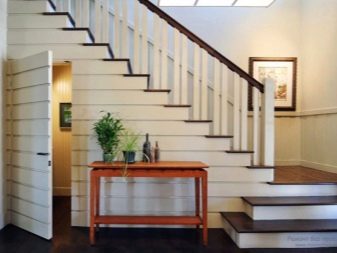Features of stairs from solid wood and design in the interior of a private house
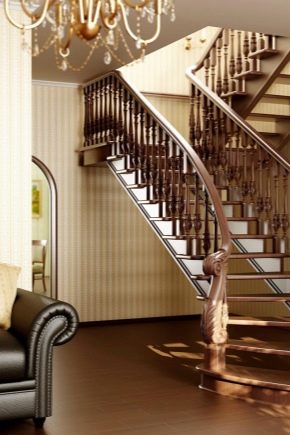
A wooden staircase in a private house will be a wonderful decoration of an elite interior, will create a warm and cozy atmosphere and will please you with a pleasant operation. The choice of wood is based on the specific specifics of the room, the requirements for operational and aesthetic qualities, as well as the cost of the material that forms the bulk of the cost of building a staircase. To create staircase structures, arrays of coniferous, hardwood and hardwood that grow in Russia are used.
Types and differences
Wood is a building material that is made from treated wood without the use of wood waste, unlike fiberboard, particleboard and similar materials.This state of affairs affects the properties of the array, determining its high quality, appearance and status, and with it the price.
The array is divided into two types:
- Whole array It is made from treated solid wood, on which there are no knots, pitch pockets and other defects. Such a selection of only flawless boards makes the material beautiful in appearance and, therefore, very expensive. The remaining features include such qualities as absolute naturalness, prestige, and high requirements for drying - here we mean that the violation of the process leads to damage and the possibility of cracking after installation.
- Glued array It is made of boards of various sizes, not suitable for the manufacture of a solid array, by gluing several layers - lamellae. Defective parts - knots, blue spots and other low-quality areas - are also absent in the high-quality glued-in array. Characteristic features include non-susceptibility to the formation of cracks, higher strength to shock loads, cheap material, high dependence of performance on the adhesive used and the use of high-strength adhesive containing synthetic components.
Below are the popular types of wood for the construction of stairs.
Pine
The advantages of pine massif include the following positions:
- well gives in to processing by planing, it is easy to drill and grind;
- easily coated with varnish and other finishing materials;
- high elasticity of the material;
- excellent smell, also very healthy;
- nice appearance.
The disadvantages of the pine massif are the low density of wood - 520 kg / cu. m, which determines the weak resistance to abrasion. It is also worth noting that the pine darkens under the influence of direct sunlight, and therefore a staircase of such material should not be located near a large window.
This wood actively "peels" with resin, which is present in excess in pine boards. Such a phenomenon will raise the varnish and form irregularities. To eliminate resin pockets and small knots, pine is subjected to the optimization process - cutting out problem areas. As a result, the joints are clearly visible on the spliced array of pieces, which significantly affects the appearance of the stairs.
Nevertheless, for its accessibility and dignity pine is recognized as one of the most popular species in the construction of stairs.
Birch tree
Wood with good performance for creating staircase structures close to valuable tree species.
The following criteria can be considered as positive features:
- Average density - 650 kg / cu. m, which is higher than conifers, but inferior to ash, oak and beech.
- High viscosity, providing excellent resistance to shock loads, - birch solid is difficult to chop. Wood has good resistance to abrasion.
- Medium hardness wood Steps from such material will serve for many years to its owner.
- Beautiful but low light texture aboutProvides the ability to give a great appearance after toning. This treatment makes the surface of the birch massif no less beautiful than expensive breeds.
- Low price wood Given the number of excellent qualities inherent in valuable wood, with skillful processing and proper operation, compensating for the characteristic shortcomings, the ratio of price and quality will be more than profitable.
- Unpretentious operation. With a timely update of the coating, which protects the wood from moisture, the birch ladder will serve for many decades.
- Good workability. The material can be easily cut, planed, peeling, grinding and other processing methods. This property allows you to create elements with complex curved geometry, and the viscosity helps not to break both in the manufacturing process and in operation.
- Wide availability. Wood of this breed grows in almost all regions of the Russian Federation, which saves on storage and transportation.
The negative aspects of the birch construction include weak decorative qualities - without additional finishing the texture is rather dull and unimpressive.
There is a vulnerability to moisture - wood quickly begins to lead at high humidity. If the varnish is not repaired in time, there is a risk of fiber rotting, the appearance of fungal mold and shortening the life of the ladder.
Birch also has a high flammability. To compensate for this disadvantage, flame retardant impregnation is used.
Ash
Belongs to the category of wood with excellent performance, but it has a heterogeneous color, which complicates the manufacture of beautiful stair products on this basis. High strength, wear resistance and durability, not inferior to oak, high resistance to any type of load - shock, abrasion and pressure - help create durable stairs. Good elasticity of wood allows you to create curly elements of high complexity, which over time do not lose their strength.
The aesthetic properties of wood do not deteriorate throughout the life of the product.
The characteristic disadvantages of an ashwood array are the following:
- the heterogeneity of the pattern complicates the creation of a solid structure with a “single landscape”;
- ash products require regular and thorough care, including inspection for the formation of small cracks and renewal of the coating.
Oak
Massive premium wood with excellent performance and aesthetic qualities. The only relative disadvantage is the difficulty of processing, due to the high strength of the material.
The following parameters characterizing the properties of the oak massif can be distinguished:
- density - 720 kg / cu. m;
- high strength, hardness, resistance to shock loads, abrasion, pressure and other influences;
- beautiful texture and shade of wood give solidity and luxury to any room, products made from such material fit perfectly into the classic interior.
How to choose?
Wood has many properties, the primacy of which in the construction of stairs is determined by the characteristics of operation. In this way, Important criteria will be such qualities:
- hardness;
- wear resistance;
- elasticity;
- strength;
- durability;
- aesthetic characteristics;
- resistance to negative factors, such as moisture and water, wood rot.
Staircase in the interior
The ladder plays a dual role in the overall design decision. On the one hand, it can act as an unusual stylish component of the interior, on the other - to bear its direct functional duty.
Therefore, before you install this installation, you must carefully consider how it will look,whether it will fit into the composition of the room and how reliable and safe its construction is.
Then you need to calculate the size and select the type of construction. It should be remembered that the angle of the march should be 30-40 degrees, and its width should not be less than 80 cm - this will meet the factors of convenience and safety of the structure. In addition, it is necessary to decide in advance on how much space will be occupied by the design of the stairs in a particular room.
If the owner of the house is the owner of a large area, then you can allow a majestic staircase, and in the case when the volume of the room is small, you should get out of the situation by completing a staircase made of translucent materials or a spatial open structure that does not visually conceal the volume.
When you have to save space at home, you can put a spiral staircase. A good way out of such a situation could be a device of a two-landing staircase with a turn of 180 degrees. The ladder can be installed with a turn of 90 degrees, which saves space by using only two walls. In this case, the ladder will look compact and at the same time meet the requirements of reliability and convenience.
You can save space by arranging built-in lockers under the marches or playground. This will achieve greater functionality of the used area.
How to do?
A staircase between floors is an indispensable element of a private house of several floors. It provides access to the upper floors, serves to separate different parts of the house, is also a decorative element of the interior. The simplest version of the production of his own hand - the implementation of a wooden staircase design.
Charting the future ladder, you must be very careful. It is necessary to calculate the acceptable height and width of the stairs, its angle of inclination, the gap between the ceiling and the step and the width of the flight of stairs in order to ensure ease of use of the structure. The parameters of each step must be the same. After making the necessary calculations and drawing up a scheme, you can mark up the tree and cut out the details of the stairs.
When treads (horizontal details of steps) and risers (vertical supports) are ready, it is necessary to attach them to the support beam with nails and bolts.When the flight of stairs is completely ready, you can install a railing to ensure the safety of using the stairs. To maintain the railing should use balusters, securing them from the bottom and top.
The fence may be wooden, like the whole staircase, or made of other materials. Its function is not only the support and safety net, but also the decoration of the stairs. The finished structure must be sanded and varnished, and it can also be painted to match the color scheme of the general interior.
The space under the stairs leading to the second floor can be adapted for storing shoes, tools, household utensils, or used as a storeroom.
How to make a staircase from an array of beech, see the following video.
